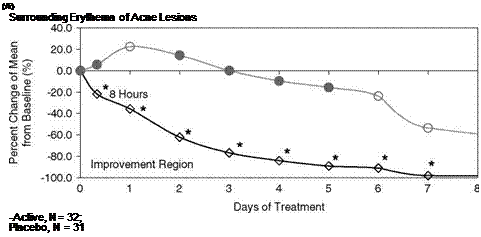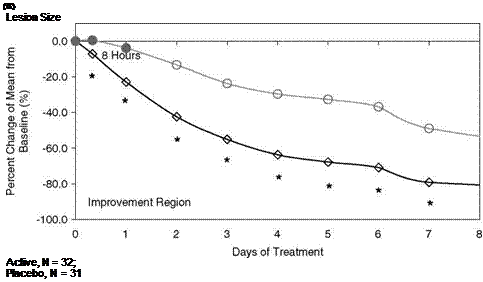SA is a keratolytic agent. It is used to treat a variety of hyperkeratotic skin disorders such as psoriasis, ichthyoses, seborrheic dermatitis, palmoplantar keratosis, keratosis pilaris, and pityriasis rubra pilaris (18). In acne, SA may reduce comedones (comedolytic) and prevent the formation of new ones by breaking down the comedonal follicular plug and by reducing follicular desquamation. It is an effective alternative for patients who do not tolerate topical retinoids. SA is approved for use in pediatric acne.
Concentrations of SA ranging from 0.5-10% from various manufacturers have been recommended for acne, but 2% is the maximum strength allowed in non-prescription acne products in the U. S. It is commonly found in acne cleansers.
The effectiveness of 0.5-2% SA as an acne treatment was originally demonstrated in two studies submitted to the FDA during the OTC approval phase (50 FR 2174, 1/15/85). The first study was a 12-week, double-blind investigation on 180 subjects comparing the efficacy of 2% SA solution versus vehicle solution and active control (5% benzoyl peroxide) in the treatment of acne. Forty percent of the subjects treated with 2% SA showed a good or excellent decrease in total lesions compared to 5% of the subjects in the vehicle group and 2% of the subjects in the benzoyl peroxide group. The study reported that SA was significantly more effective than vehicle and benzoyl peroxide in the reduction of total lesions, inflammatory lesions, and open comedones (but not closed comedones) (19). The second study was conducted on 187 subjects. Two SA formulations at 0.5% and 2% were tested against the vehicle. The results showed that both 0.5% SA and 2% SA were superior to the vehicle in reducing inflammatory lesions, open and closed comedones, and total lesions (20).
The efficacy of the cleanser form was investigated by Shalita in a cross-over study. He compared a 2% SA cleanser and a 10% benzoyl peroxide wash in 30 acne subjects. Subjects were randomly treated for two weeks with either SA or benzoyl peroxide. At the end of the first two weeks they switched treatment. The study concluded that only SA cleanser induced a significant reduction in comedones (21). More recently, a study by Pagnoni et al. (22) showed a significant reduction from baseline in open comedones count after four weeks of treatment using a 2% SA scrub or a 0.5% SA toner with 1% glycolic acid. The scrub induced a significant improvement as early as two weeks after treatment.
SA pads were investigated by Eady et al. (23). They compared 2% SA lotion versus placebo impregnated into pads. They found that the SA pads were significantly better than the control in reducing the total lesion count, starting at the fourth week of treatment. The superiority in improving comedones was also noted. Zander and Weisman reviewed three placebo-controlled studies and reported that SA pads were effective in reducing the number of primary lesions and thereby the number and severity of all lesions associated with acne (24). They also reported that SA was superior to benzoyl peroxide in reducing the total number of acne lesions.
Based on these previous studies, SA is generally considered less effective than benzoyl peroxide in the treatment of inflammatory acne but more effective in the treatment of comedonal acne.
Recently a new paradigm on SA has been ushered in when an acne treatment gel containing 2% SA was shown to be as effective as a 10% benzoyl peroxide lotion in all acne-related parameters. Because of the drying and irritating potentials of acne active
Table 1 Anti-acne Efficacy Comparison of a 2% Salicylic Acid Treatment Gel Containing Skin Soothing Naturals with a 10% Benzoyl Peroxide Lotion
Mean change from baseline (%)
|
2% Salicylic acid gel 10% Benzoyl peroxide (N = 44) lotion (N = 46)
Shading indicates a significant change from baseline (p <0.05). a Significantly higher improvement compared to the other treatment (p <0.05). |
ingredients, some of today’s acne treatment products are formulated with cosmetic ingredients or cosmoceuticals that can help soothe the skin and reduce irritation. This approach has proven very effective in optimizing efficacy for OTC acne products containing SA.
A SA gel formulated with a proprietary soothing blend of naturals was compared to a 10% benzoyl peroxide treatment lotion, to the vehicle and also to no treatment control in double-blind and randomized clinical studies (25,26). The 2% SA treatment gel was found to be at parity to 10% benzoyl peroxide in target lesion resolution and on par or even superior in reducing closed comedones and inflammatory lesions (Table 1).
The effects on the target lesion resolution was evaluated by assessing lesion erythema, size and elevation and surrounding erythema. Significantly faster resolution was observed with the active treated group versus the vehicle group and the untreated group in blinded and randomized clinical evaluation (Fig. 1).
When it comes to irritancy, the 2% SA gel was superior to the 10% benzoyl peroxide lotion in mildness. Skin soothing benefits were evidenced in the reduction of pimple associated discomfort and the lessening of global erythema. These effects were observed in the majority (70-90%) of the study subjects. Similar gentle yet effective treatment benefits were also noted with another SA treatment in a lotion base (27).
Yamamoto et al. (28) have reported diminished water barrier function in acne patients. The strong vehicle effects often observed in acne clinical studies might be due to the vehicles being less drying. Thus, having a delivery vehicle that helps improve skin moisturization can have a positive impact in the treatment.
Recently, Chantalat et al. (29) reported the use of a microgel complex to optimize SA’s anti-acne efficacy through solubilizing sebum and enhancing the delivery of SA. This microgel complex is a multiple-phase system consisting of micro-droplets in an aqueous phase. High-performance liquid chromatography (HPLC) analysis of
 |
 |
Figure 1 Blinded clinical expert grading of (A) surrounding erythema and (B) lesion size comparing a salicylic acid gel with a synergistic blend of skin soothing naturals (active) and its vehicle control (placebo). Note: open symbols denote mean values that are significantly different from baseline (p < 0.025). Asterisks next to the data points denote between treatments difference in favor of the labeled treatment (p <0.01).
microgel complex formulations with SA shows that the distribution of SA is significantly higher in the hydrophobic phase than the aqueous phase. In vitro investigations with model sebum compositions showed that certain components of the microgel complex solubilize sebum. Using fluorescence spectroscopy, ultraviolet (UV) light imaging, and confocal microscopy, they demonstrated in vivo that the depth of SA penetration in the skin was increased, as was the extent of deposition. Furthermore, skin conductance and transepidermal water loss (TEWL) measurements showed that formulations with the microgel complex delivered greater moisturization benefits versus placebo. This microgel formulation containing SA was shown to be highly effective not only at treating existing acne lesions but also at ameliorating emerging acne pimples—the sub-surface acne lesions that are not yet visible on the skin surface (30).
